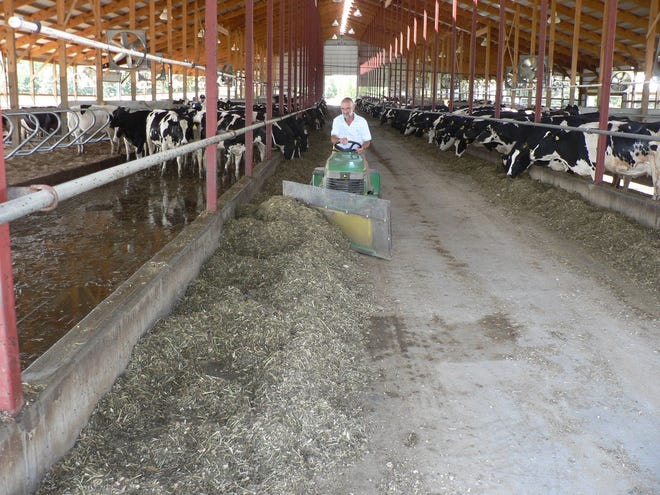Controlling feed costs key to dairy profitability

Green Bay – Of all the costs related to operating a dairy farm, feed costs are the only part a producer can actually control, according to Dr. Mike Hutjens a retired professor from the Illinois College of Agricultural, Consumer & Environmental Sciences.
Hutjens was the leadoff speaker at the recent Dairy School presented by Alltech Wisconsin, a leading provider of quality dairy nutrition products and on-farm support.
He says producers can expect fuel cost increases of 50-60%, used truck prices 26% higher and labor costs 10-20% higher this year. “From October 2020 to 2021 fertilizer prices have also soared from 90% to 163%,” Hutjens reported.
“With feed representing 55% of total farm expenses, it’s vital to keep them under control,” he said. “The only reason to raise livestock is to increase return on crops raised on the farm.”
Using a herd of 3,000 cows producing an average of 83 pounds of milk per day, with 181 days in milk as an example, Hutjens noted milk income of $17.79 CWT, and a breakeven price of $16.94, or 79 pounds of milk.
Breaking down the costs per cwt, he reported feed costs at $9.28, cull cow expenses at $2.55, labor at $1.77, milk hauling at $1.01, maintenance and repairs at 49¢ and health at 42¢.
Feed efficiency
Hutjens noted that during 2021, corn prices rose over $2.20 a bushel, soybean meal was up $25 a ton and hay prices jumped more than $200 per ton.
“Know your feed costs,” he advised. “Feeding forages, grain, byproducts, protein supplements, mineral and vitamin supplements and ration balancing services, the feed costs per day were $5.76 per cow,” he explained.
Based on an 80-pound per-day herd average, feed costs per 100 pounds of milk are $7.20, with income of feed cost $10.80 per cow and a feed efficiency of $1.63 per pound of milk/ per pound of dry matter. With a 70 pound per day average, feed costs increase to $8.20, income drops to $9.80 and feed efficiency drops to $1.43.
“To help understand the power of feed efficiency (pounds of 3.5% FCM divided by pounds of DM consumed), compare the level of dry matter intake to fat or energy-corned milk yield,” Hutjens stated. “Compare different groups in the herd and measure the change when feeding and management changes are made.”
He related that a high group of mature cows had a feed efficiency for 1.7, a high first lactation group was at 1.6 and fresh cows 21 days in milk had a feed efficiency of 1.5. “Be concerned if efficiency drops below 1.3,” he warned.

Feed costs, quality
Hutjens said it’s vital to know current feed costs and break-even prices. He noted that as of October 2021, shelled corn was $201 per ton, while the beak-even price was down at $189. The canola meal price was $350 but the break-even price was $267. It was the same for poor meat meal, with the break-even price $46 below the market price.
Corn silage, high quality alfalfa and soybean heated meal were all below the break-even prices. Corn silage was $40 a ton with a break-even price of $93; alfalfa, at $230 per ton, was $18 under the break-even price, and soybean meal was $403, $104 below the break-even price.
Distlllers grain and corn gluten feed were also selling below break-even prices, at $206 per ton and $167 per ton, respectively.
“Focus on forage quality, when considering alfalfa haylage, grass silage, corn silage and small grain silage,” said Hutjens.
He recommends focusing on moisture, crude protein and the relationship of minimum forage NDF and maximum starch levels.
Nutrient feeding
“Use a rumen model to fine- tune nutrient digestibility, fill factors and dry matter intake,” said Hutjens.
He also recommends grouping lactating cows according to fresh, early lactation, late lactation and first lactation.
Optimizing rumen fermentation is also important. “Feed adequate levels of rumen- degraded protein to maximize microbial protein yield, including 65% of amino acids from bacterial sources,” he advised.
Hutjens also recommends balancing starch to optimize dry matter intake with 70% of energy coming from carbohydrates, and monitoring for signs fo subacute rumen acidosis, and adding a buffer if needed.
Feed bunk management
Hutjens says cows need 30 inches of bunk space, and recommends providing fresh feed at a consistent time, ideally after each milking. “Push feeds one hour before milking and every 2 to 4 hours after milking,” he stressed.
He advises monitoring the bunk for signs of sorting. “See if cows are moving feed to sort out concentrates, evaluate build up of residue film and odors, and consider sealing the surface with plastic, tile or sealing paint,” Hutjens said.
He also recommends feeding additives, including rumen buffers, yeast products, silage inoculants, biotin and organic trace minerals.
As needed, he suggest adding propylene glycol or glycerol, calcium propionate, niacin, mycotoxin binders and acid-based preservatives such as baled hay and high-moisture corn.
Transition feeding programs are also important, according to Hutjens. “Place dry cows in two groups. Feed far-off dry cows a lower-energy diet, and for close-up dry cows add starch,” he said.
For fresh cows, he recommends increasing starch and lowering NDF, while continuing to monitor cow health.
Summing up, Hutjens advised producers to utilize all available tools to measure optimal performance, control the controllable feed cost, optimize milk yield and components. “But you may not be able to save your way to profits,” he cautioned.